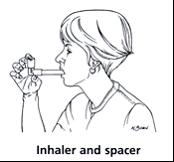Dr. M.J. Bazos MD,
Patient Handout
Asthma
Medications
What medications are used to treat
asthma?
Most people with asthma need 2 kinds of asthma
medicine: 1 for quick relief and 1 for long-term control.
Everyone with asthma needs a quick-relief
medicine to stop asthma attacks. Many people also need a preventive medicine, or
controller, every day to protect the lungs and keep asthma attacks from
starting.
Make sure you have a written treatment plan from
your doctor and understand how to follow it.
How safe are preventive medicines
for asthma?
Preventive medicine makes the airways less
swollen. Preventive medicines for asthma are safe to use every day. You will not
become addicted to these medicines even if you use them for many years.
Your doctor may tell you to take preventive
medicine every day if:
- You cough, wheeze or have a tight chest more than
once a week.
- You wake up at night because of asthma.
- You have many asthma attacks.
- You have to use quick-relief medicine every day
to stop asthma attacks.
Be prepared. Always
have asthma medicine.
Always carry your quick-relief asthma medicine
with you when you leave home. Follow the instructions in the box on the next
page.
Act fast if an asthma attack
starts.
Know the signs that an asthma attack is
starting:
- Coughing
- Wheezing
- Tight chest
- Waking up at night
If you know what started the
attack, avoid it if you can.
Use your quick-relief asthma medicine.
Stay calm for 1 hour to be sure breathing gets
better.
What if I don't get better?
Get emergency help from your doctor if you do
not get better.
Call your doctor or seek emergency care if you
see any of these asthma danger signs:
- Your quick-relief medicine does not help for very
long or it does not help at all.
- Breathing is still fast and hard.
- It is hard to walk or talk.
- Lips or fingernails turn gray or blue.
- Your nose opens wide when you breathe.
- Skin is pulled in around the ribs and neck when
you breathe.
- Your heartbeat or pulse is very fast.
Can I use the
quick-relief medicine too much?
Quick-relief medicine for asthma makes you feel
better for a while. It may stop the attack. With some attacks, you may think you
are getting better but the airways are getting more and more swollen. Then you
are in danger of having a very bad asthma attack that could kill you.
If you use quick-relief medicine every day to
stop asthma attacks, this means you need a preventive medicine for long-term
control.
|
How to Use a Spray Inhaler
Without a spacer
- Take off the cap. Shake the inhaler.
- Stand up. Breathe out.
- Put the inhaler in your mouth or put it just in
front of your mouth. As you start to breathe in, push down on the top of the
inhaler and keep breathing in slowly.
- Hold your breath for 10 seconds. Breathe out.
With a spacer
(A spacer, or a holding chamber, makes it easier
to use a spray inhaler.)
- Put the open end of the spacer in your mouth.
- Spray the asthma medicine into the spacer one
time.
- Take a deep breath and hold it for 10 seconds.
- Breathe out into the spacer.
- Breathe in again, but do not spray the medicine
again.
|
Adapted from "What you and your family can do
about asthma," a patient information booklet published by the Global Initiative
for Asthma, a joint effort of the National Heart, Lung, and Blood Institute and
the World Health Organization. This and other publications are available through
the Internet (http://www.ginasthma.com).

